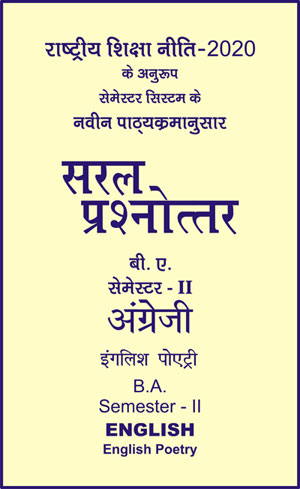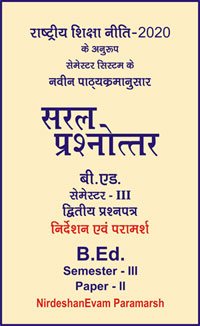|
बी ए - एम ए >> बीए सेमेस्टर-2 - अंग्रेजी - इंगलिश पोएट्री बीए सेमेस्टर-2 - अंग्रेजी - इंगलिश पोएट्रीसरल प्रश्नोत्तर समूह
|
|
|||||||
बीए सेमेस्टर-2 - अंग्रेजी - इंगलिश पोएट्री
Chapter - 13
"My Last Duchess'
- Robert Browning
Life and Works of Robert Browning
Robert Browning was born on May 7, 1812 at Comberwe (Cornwall). His father was a clerk in the Bank of England and his mother came from a mixed- blood family of the German and Scotch descent. He called his mother 'a divine woman' and was very much devoted to her. The boy did not join any school and a university. He received much of his education from private tutors. He developed sympathy and love for Greek literature quite early in life. In the age of seventeen he went to university for a short term. He studied the books which he found in his father's library with great attention and interest. Though not a student he became well versed in such accomplishments as riding, boxing and dancing. He joined a hospital to follow a medical profession. But he could not stick to this idea for long and his desire to be a poet was born in when he was only seven or ten years old. During the year 1833 when he was only twenty one years old an opportunity took him to Russia. He stayed in Russia for three months in the company of the Russia council of general. It was in 1845 that he met his future wife 'Elizabeth Barret' a sickly lady whose poems had impressed Browning very much. Browning was thirty four and Elizabeth was three years elder. On september 19, 1846 they were quietly married at marylebone church.
The couple was got a son in 1849. But very soon Mrs. Browning's health started failing gradually. Browning had to came back to London because of the poet's father's death. But he came to know that his son had became a painter and had settled in Italy. Browning used to go to his son once a year. During his visit to his son in 1889, he caught chill and bronchitis and passed away in December 12.
His Works Browning's first poem published in 1833. It was 'Paulin'. The Poem 'Sordello' containing 6,000 lines was published in 1840. His Dramatic lyrics came in 1842. It was followed by Dramatic Romances and Lyrics in 1845.
But that collected included such pieces as Evelyn Hope, Porphyria's Lover My Last Dutches, The Pied Piper Hamelin, Meeting at Night, By the Five Side, Home Thoughts from Abroad, etc. His other lyrical passages as Balaustion's Adventure in 1871, Fifine at the Fair in 1872, Red Cotton Night- cap country in 1873, Jocoseria in 1873. Another notable literary pieces of Browning's collection, which was dedicated to his wife Elizabeth as Fra lippo lippi, Andrea Del Sarto, One Word More.
Browning's famous volume of the poems was Dramatic personal which appeared in 1864. It is a collection of studies of men and women as his two previous collection had been. Bishop Blougram, Rabbri Ben Ezra and A Death in the Desert are the most known of its contents. The Rring and the Book that came in 1868-69 is the crowing effort of his genius.
Robert Browning: My Last Dutches
Introduction of the Poem
My Last Dutches is one of the most well-known dramatic monologue of Robert Browning. It is the study of the psychology of Duke of Ferrara. The poem begins in the upper storey of the princely palace in Ferrara. Duke introduces the messenger to the painting of his Last Dutches on the wall. The painting was made by Fra Pandolf. It was a wonderful piece of work. It was a lovely figure drawn by the artist. The lady painted in the picture is smiling impressively. It was her habit to welcome everybody with smiling. She was an innocent lady who was easily pleased and she praised everything. On the other hand the Duke was too proud to point out her these 'weaknesses,' therefore, she could not know that her husband did not like them.
Substance of the Poem
My Last Dutches' is a study of the psychology of the Duke of Ferrara. He has got his wife killed. It was so because she had sweet and impressive nature. He could not tolerate these behaviours in her. So when she could not mend hereself, he got her killed. When a messenger from the neighbouring state came to talk of the second marriage, the Duke told him story in a satarical, haughtly and cunning way. The virtues of the Last Dutches were described as if they were vices. And he did not fail to mention his claim for just pretence of dowry rather than I took interest in your beautiful daughter.
कविता का हिन्दी सारांश
कविता My Last Dutches फेरारा के ड्यूक का मनोवैज्ञानिक अध्ययन है। उसने अपनी पत्नी की हत्या की थी। ऐसा इसलिए हुआ था क्योंकि वह देखने में सुन्दर और प्रवृत्ति से प्रभावी थी। वह पत्नी के इस व्यवहार को बर्दाश्त नहीं कर सकता था। जब वह अपनी मिथ्या या गलती में सुधार नहीं कर सकी तो उसने उसकी हत्या करवा दी। जब पड़ोसी राज्य से एक संदेशवाहक ड्यूक की दूसरी शादी का प्रस्ताव लेकर आया तो ड्यूक ने उसे यह कहानी बड़े व्यंग्यात्मक और घमंड भरे स्वरों में सुनायी। ड्यूक अपनी पत्नी लास्ट डचेस की निपूर्णताओं को ऐसे बताता है जैसे कि वह घृणित तथ्य थे और उसने कह कि मुझे दहेज में उतनी रूचि नही जितना कि मुझे आपकी सुन्दर लड़की में ।
Points to Ponder (About the Poem)
1. My Last Dutches is the study of the psychology of the Duke Ferra.
2. The painting of lady was made by Fra Pandolf and the picture is as smiling impressively.
3. The Duke could not tolerate these virtues in his wife and he got her killed.
|
|||||
- Chapter - 1 Forms of Poetry & Stanza Forms
- Objective Type Questions
- Answers
- Chapter - 2 Poetic Device
- Objective Type Questions
- Answers
- Chapter - 3 "Let Me Not to the Marriage of True Minds" (Sonnet No. 116)
- Objective Type Questions
- Answers
- Chapter - 4 "On His Blindness"
- Objective Type Questions
- Answers
- Chapter - 5 "Present in Absence"
- Objective Type Questions
- Answers
- Chapter - 6 "Essay on Man”
- Objective Type Questions
- Answers
- Chapter - 7 "Elegy Written in a Country Churchyard”
- Objective Type Questions
- Answers
- Chapter - 8 "The World is Too Much with Us"
- Objective Type Questions
- Answers
- Chapter - 9 "Ode on a Grecian Urn"
- Objective Type Questions
- Answers
- Chapter - 10 "Break, Break, Break"
- Objective Type Questions
- Answers
- Chapter - 11 "How Do I Love Thee?"
- Objective Type Questions
- Answers
- Chapter - 12 "Dover Beach"
- Objective Type Questions
- Answers
- Chapter - 13 "My Last Duchess'
- Objective Type Questions
- Answers
- Chapter - 14 "The Love Song of J. Alfred Prufrock"
- Objective Type Questions
- Answers
- Chapter - 15 "The Lake Isle of Innisfree"
- Objective Type Questions
- Answers
- Chapter - 16 "Church Going"
- Objective Type Questions
- Answers
- Chapter - 17 Rhetoric and Prosody - Practical Criticism
- Objective Type Questions
- Answers

 i
i 










